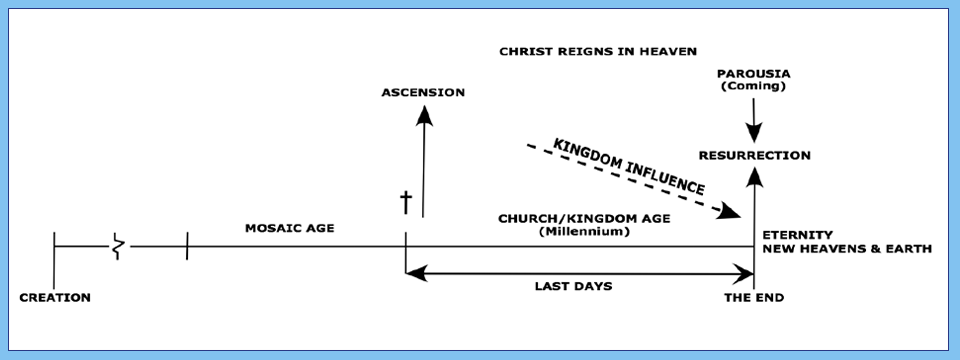The following diagram depicts the general contours of amillennialism:

Amillennialism was “first given systematic expression by St. Augustine in his famous City of God,”1 written in AD 413. Of all prophetic systems, this view has enjoyed the widest acceptance for the longest period. Modern proponents of amillennialism include J. I. Packer, Anthony Hoekema, and R. C. Sproul.
Kim Riddlebarger, who abandoned dispensationalism to embrace amillennialism, provides a description of this model:
Amillennialists hold that the promises made to Israel, David, and Abraham in the Old Testament are fulfilled by Jesus Christ and his church during this present age. The millennium is the period of time between the two advents of our Lord with the thousand years of Revelation 20 being symbolic of the entire interadvental age. At the first advent of Jesus Christ, Satan was bound by Christ’s victory over him at Calvary and the empty tomb. The effects of this victory continued because of the presence of the kingdom of God via the preaching of the gospel and as evidenced by Jesus’ miracles. Through the spread of the gospel, Satan is no longer free to deceive the nations. Christ is presently reigning in heaven during the entire period between Christ’s first and second coming. At the end of the millennial age, Satan is released, a great apostasy beaks out, the general resurrection occurs, Jesus Christ returns in final judgment for all people, and he establishes a new heaven and earth.2
This account provides the information we need to answer the test questions we posed here:
Q. 1. What does this model teach about Israel after the flesh (1 Corinthians 10:18)?
A. Amillennialism teaches Israel after the flesh no longer holds a special covenant position with God. The promises made to Abraham and his descendants now apply to the church, defined as those having faith in Christ. The church is now the Israel of God.3
Q. 2. What does this model teach about the thousand year reign of Christ as described in Revelation 20:2–7?
A. Amillennialists do not believe the reign of Christ in Revelation 20 is a literal 1000-year period.4
Q. 3. What does this model teach about the Second Coming of Christ in relation to the millennium?
A. Amillennialism teaches Christ will return after the millennium, or church age.5
Q. 4. What does this model teach about the kingdom of God in history?
A. Amillennialism does not expect the victory of Christ’s kingdom over the forces of evil in history.
“The forces of evil will grow worse and worse in the world, as Satan in his madness uses every power at his command to overthrow the church of Christ. . . . We have no hope or expectation that the whole world will grow better and better until it is all converted to Christianity. . . . We by no means expect that the whole of society will be Christianized. In fact, we expect the forces of evil to grow more and more violent in their opposition to Christianity and Christians.”6
Footnotes
- Kim Riddlebarger, A Case for Amillennialism: Understanding the End Times (Grand Rapids: Baker, 2003), 32.
- Riddlebarger, A Case for Amillennialism, 312.
- Riddlebarger, A Case for Amillennialism, 117–23.
- William E. Cox, Amillennialism Today (Phillipsburg, NJ: Presbyterian and Reformed, 1966), 1–6.
- Cox, Amillennialism, 82–98.
- Floyd E. Hamilton, The Basis of Millennial Faith (Grand Rapids: Wm. B. Eerdmans, 1942), 34-36.
